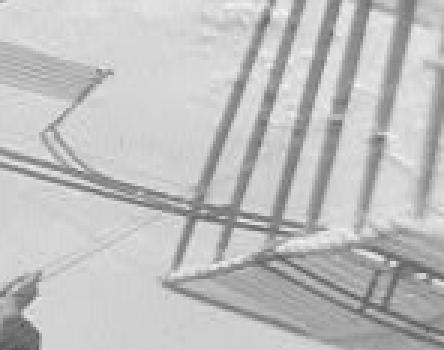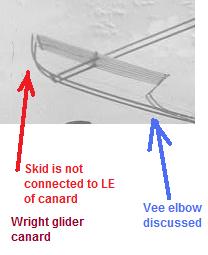| Page 3 of December 2010 Lift |
| http://lcweb2.loc.gov/pnp/ppprs/00500/00580v.jpg
Study V support at TE of canard.
Trailing edge of the canard surface: this is an “elbow” hinged control
arm that attaches directly to the control stick. More than a
support: this is the canard surface control mechanism.
The canard is connected at the center pivot to the down struts
which connect to the landing runners. The rear surface (trailing
edge) connects to these two elbow hinged controls. As this canard gives a very positive control, it has a neutral CG; but in flight the canard must be constantly adjusted by the pilot as it cuts into the wind. Precisely why this canard design was eventually replaced in 100% of aircraft construction because it has no neutral stability to return to “center” or level. This fact of design was explained by Master Wright Builder / Historian Tom Valentine, who built over four flying full-scale replica versions of Wright “canard” type aircraft. Valentine explains that, because of the positive forces directed onto the canard constant re-correction must be made to bring the aircraft back from radical pitch. Since the canard works as a rudder at the front of a boat it causes deliberate action which does not bring the aircraft into a neutral flight plane and is very difficult to control by the most experienced licensed pilots. A canard pilot must constantly “correct” because the control surface is inclined to pitch further in a given direction--up or down--as wind/air acts on the leading edge of the canard, explained Tom Valentine. A close-up detail of the photo this “V” support can more clearly be seen and the actual articulating joint of the “elbow” control will more clearly reveal a mechanical hinged set of two control arms. One arm attaches to the control “stick” while the other is a carefully matched “drone” hinge which acts to keep the canard surface even from left to right. A well designed apparatus with intrinsic instability: the canard forward control elevator. Those who do not learn from history are doomed to repeat it. Naturally the Wrights opted to move the elevator to the aft of the ship as it could be properly trimmed into a neutral position and keep an airplane flying level in a hands-free event. Remarks above are recalled from a conversation with Tom Valentine with |
|
|

